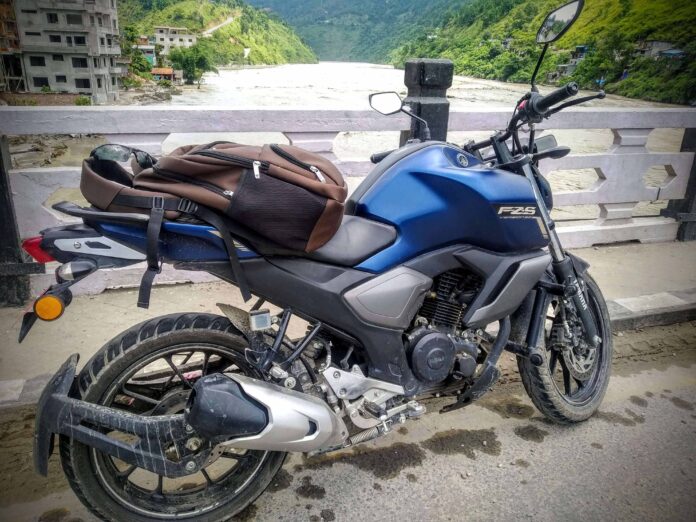I have been riding the Yamaha FZS FI V3 for more than a year, and have good experience riding it in different road conditions.
Are you also planning to buy the FZS FI V3? If yes then, this article might be helpful for you to make the decision.
In this review article, I will try to explain my personal experience with the FZS FI V3, its positive, and negative aspects, performance, and much more. So, let’s get started…
First, let’s explore the basic information of the Yamaha FZS FI V3.
The new Yamaha FZS-FI V3 is one of the popular bikes in Nepal, and it comes with Yamaha’s Blue Core technology for enhanced performance and efficiency. It is available in the Nepali market for a price of Nrs. 3,34,900.
The bike weighing 137kgs is powered by an air-cooled 4-stroke 149cc SOCH, 2-valve, single-cylinder FI (Fuel Injected Engine) that produces a maximum power of 9.7 kW at 8000 r/min, and a maximum torque of 12.8 Nm at 6000 r/min.

The FI technology equipped in the bike is responsible for making intelligent use of sensors, and actuators to analyze and deliver the perfect amount of fuel to the engine.
One of the important features of the FZS FI V3 is the single-channel Anti-Lock Braking System (ABS) that enhances optimum braking performance during high speeds.
The bike comes with a negative LCD instrument cluster that contains a bar-style tachometer, digital speedometer, ABS warning lamp, odometer, fuel gauge, Trip 1, Trip 2, clock, and others that can be selected for display. In addition, the instrument cluster also features an ECO indicator that allows more fuel-efficient riding.
Now that, we have some basic knowledge of the bike, let’s move towards the review based upon my 1 year of riding experience.
I would like to categorize the review into six aspects including Performance, Comfort, Handling, Safety, Fuel Efficiency, and Maintenance Cost. Besides, I will also include the pros and cons of the bike below.
Performance
As the Yamaha FZS FI V3 is powered by a 149cc engine, it offers average power, and performance. You can’t expect high-level pickup, and performance however, it performs well as a commuter bike.
I have been riding this bike on highways frequently, and the performance during cruising is excellent. But the concern here is you will struggle during a hill climb, and steep roads as the bike disappoints you with its pickup power.

If you are alone on your FZS FI V3, you won’t get pickup issues during uphill rides but you will feel it with the pillion rider. The initial pickup of the bike is also average because you will experience less power during overtaking.
You must have been wondering about the off-road capability of the bike.
As per the company, the bike is not actually made for off-road rides but for city rides. However, it can be utilized for off-road traveling with certain limitations such as low ground clearance, and less pickup.
The ground clearance of 165mm offered by the bike is not enough for off-road riding as you will experience collisions with stones, bumps, muds, and other obstacles. And you need to apply more stress to the engine for getting past the obstacles during your off-road journey.

Besides these drawbacks, the bike performs well in other riding conditions. The experience with FZS FI V3 becomes enjoyable while riding on smooth blacktopped roads.
The good point about the performance of the bike is that it performs well in good road conditions, and offers smooth riding without vibrations even during higher speeds. I have achieved a top speed of 100 kmph during highway rides and did not encounter any issues.
Another good point is the bike doesn’t get overheated even with long rides. In my experience, I have traveled almost 350 kilometers in a day with it but the bike remained cool with consistent performance.
Comfort
When it comes to comfort, the Yamaha FZS FI V3 offers a comfortable riding experience and is best in enhancing your pleasant journey. The seat quality is also good, and you can add an extra layer of the seat cover to make it cozier.
The seating position is upright so, you feel comfortable during long rides. As I have traveled a lot on highways, I have not encountered body aches. Sometimes, I felt some leg discomfort however, it is common during long rides even on the comfiest bikes. So, it is not a major issue for your FZS FI V3.

Handling
The handling offered by the bike is excellent, thanks to the suspension and frame setup. I felt too easy, and comfortable while taking sharp turns and changing directions.
Safety
The Yamaha FZS FI V3 comes with a single-channel Anti-Lock Braking System (ABS) on the front wheel. The ABS works exceptionally well in higher speeds and emergency conditions. During my ride, I have already tested the ABS capability of the bike.
I would like to share a story about an incident with my FZS FI V3 that reflects the amazing safety feature of the bike.
One day, I was on my journey from Sindhupalchowk to Kathmandu. I was enjoying my ride with the beautiful nature, and the newly blacktopped smooth road added more joy. The speed of my bike was around 50-55 kmph when a small kid suddenly crossed the road in front of my bike. I suddenly applied the front brake equipped with ABS, and the bike stopped with some minor jolts. I was able to save the kid, and the bike reacted well enough to prevent possible skidding and crashing. From this incident, I realized the importance of the ABS system.
Having said that, I would like to conclude the ABS feature of FZS FI V3 works exceptionally well in emergency conditions.
Fuel Efficiency
Another plus point of purchasing the FZS FI V3 is the fuel efficiency as the bike is equipped with Fuel Injection (FI) technology that intelligently manages the fuel required for the engine.
As per my experience, the bike offers a mileage of almost 40 kmpl in city rides and nearly 45 on highway rides. This statistic is fully based upon my riding technique so, it may differ slightly according to yours.
Maintenance Cost
The maintenance cost for Yamaha FZS FI V3 is average.
I have already crossed 7000 kilometers on my FZS V3, and servicing has been done four times. I had to replace rear brake pads during the 5000 kms, and it cost around Nrs. 2400.

The bike needs to get serviced every 1500-2000 kms. During each servicing, the engine Mobil, and oil filter must be changed. The cost of Mobil is Nrs.965, and the oil filter is Nrs. 140. So, the total cost during each servicing comes around Nrs. 1600 and it may slightly change with the varying servicing charge. The Yamaha company provides 5 free servicing after you purchase the new bike.
The servicing cost for the FZS FI V3 is not that expensive however, the spare parts may be costly.
With that, let’s discover some positive, and negative aspects of the Yamaha FZS FI V3.
Positive Aspects
Fuel Efficiency
The bike offers greater fuel efficiency due to the fuel injection technology.
Comfort
The riding experience is better with the seating position and design of the bike.
Safety
The FZS FI V3 is featured with a single-channel Anti-Lock Braking System (ABS).
Design
The design of the bike is muscular, stylish, and offers better looks.
Negative Aspects
The negative aspects mentioned below are based on my personal experience so, they may differ with other FZS V3 owners.
Poor Build Quality
The build quality of the Yamaha FZS FI V3 is weak as the parts get loosened easily due to the plastic build quality. The tank section is vulnerable and the plastic cover gets detached easily. Some FZS FI V3 owners may not experience this issue however, the majority of the owners have their tank cover loosened quickly. My bike has also been the victim of this issue.

You don’t have any options to tighten it as you have to replace the whole setup. The servicing center told me the tank cover can’t be tightened, and it needs to be replaced after the loosening gets worst.
Another section that reflects the poor build quality of the bike is the side cowling that also gets loosened too easily, and it also requires full replacement.

I think Yamaha must look into these issues before launching a new version of the FZS FI V3.
Tire Issue
After I purchased the Yamaha FZS FI V3, I found later that the bike comes with MRF and CEAT tires. My bike was equipped with CEAT tires, and it was the worst thing to happen.

The CEAT tires on the bike are not that great as it is vulnerable to small nails, needles, steels, or any other Foreign Object Debris (FOD). I had to seal the tire five times with the tubeless tire puncture kit.
The rear tire does not react well in slippery road conditions. The normal flow of the bike gets disturbed while applying an even smaller amount of rear brakes in wet, and slippery conditions. So, you need to be careful while braking during slippery conditions.
So, it will be better if you choose the MRF tire instead of CEAT. If MRF is not available, you can ask the dealer about the authenticity of the available tire.
Yamaha FZS FI V3 Pros & Cons
Pros
- Fuel-Efficient
- Good Handling
- Comfort
- Safety with ABS
Cons
- Poor Build Quality
- Tire Issue
- Less pickup
Conclusion
In my experience of almost 1 year with the Yamaha FZS FI V3, I am satisfied with the bike. Although there are some negative parts of the bike, however, the positive aspects outweigh the negative ones.
While purchasing the bike, you need to first clarify your requirements like riding purpose, budget, and intention.
If you are looking for a bike with a reasonable price, important features, fuel efficiency, and comfort then, the Yamaha FZS FI V3 is a good choice.




![Brand-new TVS bikes price in Nepal [Updated 2022] TVS-bikes-in-nepal-gadgetsgaadi](https://gadgetsgaadi.com/wp-content/uploads/2021/06/TVS-bikes-in-nepal-gadgetsgaadi-218x150.jpg)